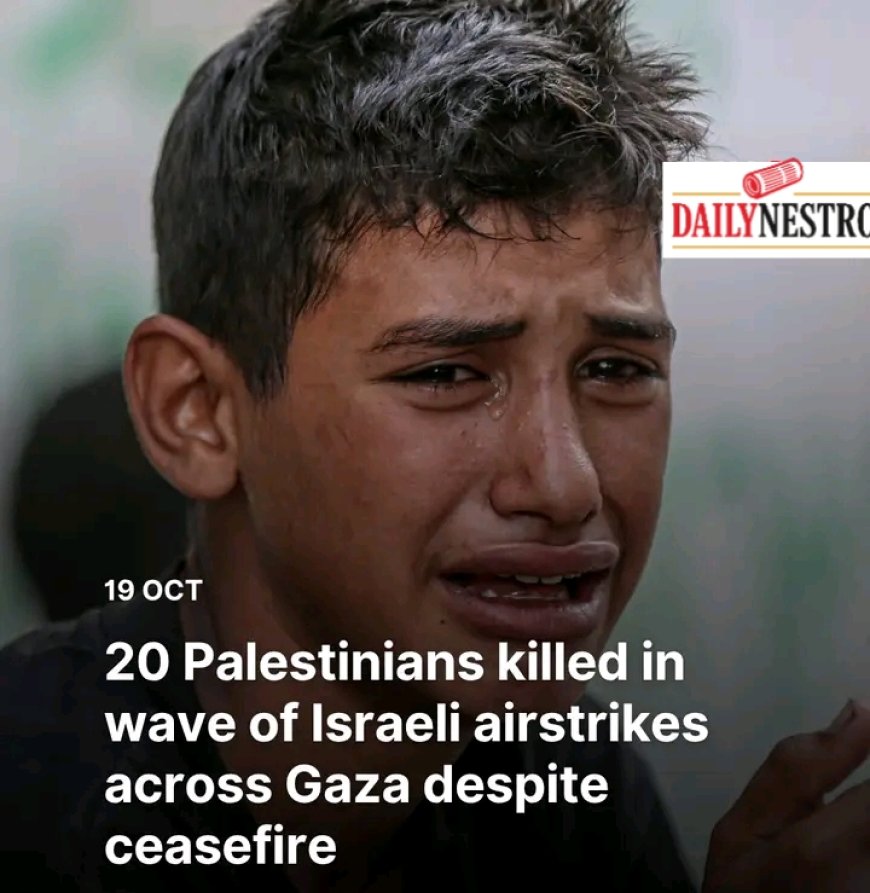20 palestinians killed in wave Israel strikes across Gaza despite ceasefire
Israeli strikes kill 26 people after two soldiers killed.

Renewed Airstrikes in Gaza Leave At Least 20 Dead Despite Ceasefire Agreement
Ongoing Tensions Undermine Peace Efforts in Gaza Strip.
Despite an active ceasefire agreement between Israel and Hamas, at least 20 Palestinians were reported killed on Sunday in a wave of Israeli airstrikes across the Gaza Strip. Medical sources and eyewitnesses shared details of the incidents, which included strikes on residential areas, temporary shelters, and refugee camps — locations where many civilians, including displaced families, have sought safety.
The escalation has drawn international concern, as hopes for sustained peace in the region continue to be challenged by recurring violence.
Residential and Civilian Areas Among Targets
One of the most deadly incidents occurred in the central Gaza town of Al-Zawayda where a fighter jet reportedly struck a coffee shop situated in a densely populated residential neighborhood. Medical teams confirmed that at least five people were killed in the strike, while several others sustained injuries. The area is known for housing hospitals and displacement camps, making the attack particularly alarming for humanitarian organizations working on the ground.
Shortly thereafter four more Palestinians were killed and 13 others injured when an airstrike hit a tent sheltering displaced individuals inside a school in the Nuseirat refugee camp also located in central Gaza. Among the injured were several children, further highlighting the ongoing risks faced by vulnerable populations in the conflict zone.
In the same refugee camp, another strike reportedly hit the vicinity of the Al-Ahli Club resulting in two more deaths. Additional civilian casualties were also reported in other parts of the Nuseirat camp, where three people were confirmed dead following further airstrikes.
BNorthern and Southern Gaza Also Affected
The violence extended beyond central Gaza. In the northern town of Beit Lahia an Israeli drone reportedly targeted an area near Kamal Adwan Hospital killing two individuals. Strikes in this area are particularly concerning due to the close proximity to medical facilities, which are already under immense strain due to ongoing conflict.
Meanwhile, in the Bureij refugee camp another central Gaza location, an airstrike struck a residential home, leading to the deaths of four people and causing injuries to eight others, according to local reports.
In the southern Gaza city of Khan Younis two civilians were injured following a strike on a displacement tent west of the city. Local witnesses described scenes of panic and confusion as people scrambled to seek shelter.

Military Operations Escalate in Khan Younis
The Israeli military reportedly initiated a concentrated offensive, referred to by sources as a “belt of fire,” in the eastern neighborhoods of Khan Younis. These areas are currently under Israeli military control and have been designated as combat zones. Artillery fire and airstrikes were reported throughout the day, prompting many families to flee further west in search of safety.
This military escalation followed reports from the Israeli army that its forces came under missile fire and gunfire in the southern city of Rafah. The source of the attack remains disputed, as Hamas has denied any involvement in the incident.
Civilians Warned to Avoid Combat Zones
In a public statement, Israeli army spokesperson Avichay Adraee advised Gaza residents to avoid entering high-risk areas. He specifically warned civilians to remain west of the “yellow line”, a boundary established as part of the U.S.-brokered ceasefire agreement.
A map shared by the Israeli military identified two distinct zones:
▫️The yellow zone, where civilians are advised to stay, and
▫️ The red zone which the military describes as a “highly dangerous combat area” currently under active operations.
Adraee emphasized that the red-marked areas pose severe risks to anyone present, urging civilians to heed the warnings for their own safety.
International Reactions and Humanitarian Concerns
The renewed violence has sparked concern among international observers, humanitarian organizations, and human rights groups, who are calling for both sides to uphold their commitments to the ceasefire and prioritize civilian safety.
The Gaza Strip, already facing a humanitarian crisis, continues to grapple with shortages of essential supplies, including medical equipment, clean water, food, and shelter. Many families have been displaced multiple times, often forced to flee at a moment’s notice as conflict zones shift unpredictably.
Global organizations, including the United Nations and Red Crescent, have reiterated appeals for all parties to respect international humanitarian law and ensure the protection of non-combatants, particularly children, women, and the elderly.
In Conclusion:
The recent airstrikes mark yet another setback in efforts to maintain a lasting peace in the region. While ceasefire agreements offer a glimmer of hope for de-escalation, the situation on the ground remains volatile and unpredictable.
As both military actions and diplomatic talks continue, the international community remains watchful. The coming days will likely be critical in determining whether the ceasefire can hold — or whether further escalation is on the horizon.
The sources: Al-jazeera Reuters







